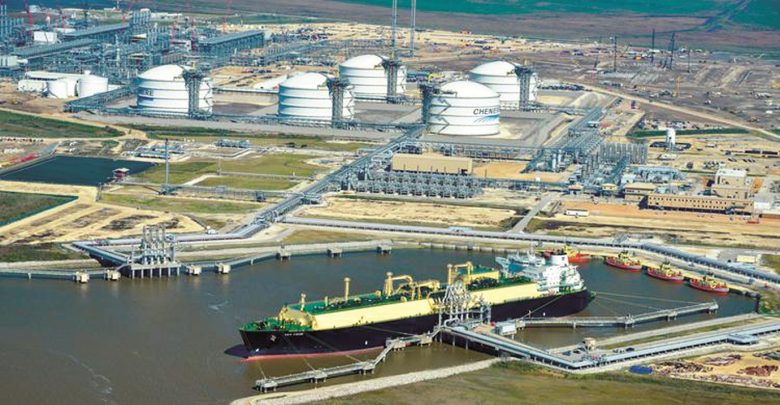
Strong demand growth, clean energy properties motivate Qatar to boost LNG production capacity: QNB
«QNB»: تعزيز إنتاج الغاز يدعم قطاعات الدولة الاقتصادية كافة
Strong growth in LNG demand and its role in supporting the transition to a low-carbon energy system is what motivates Qatar to expand its LNG production capacity, QNB has said in an economic commentary.
This increase in capacity will require huge investments in both onshore and offshore, including the construction of four new LNG mega trains to process the gas. The increase will boost Qatar’s LNG capacity from 77mn tonnes per year currently to 110mn tonnes, QNB said.
Beyond the direct impact on hydrocarbon GDP, this new investment phase, which should begin from 2020 onwards, will generate “substantial multiplier effects” for the wider economy. Qatar’s increase in LNG production will also help the environment. In addition to lower CO2 emissions, LNG has low particle emissions, low nitrogen oxide emissions and is low in sulphur emissions, making it a “much cleaner” energy source that causes “less air pollution” than any other fossil fuel.
“The concept of environmental sustainability is becoming more prominent in both Qatar’s public and private sectors. This has prompted the development of new initiatives in several state-owned and private companies. As a major fossil fuel exporter and one of the wealthiest countries in the world, Qatar is seeking to do its fair share by reducing domestic greenhouse gas emissions and developing climate adaptation plans,” QNB said.
Policymakers face a difficult challenge: how to satisfy the world’s increasing demand for energy, while at the same time attempting to reduce greenhouse gas “emissions”.
Success requires a transition to a low-carbon energy system, which makes much greater use of renewable energy and is less dependent on burning fossil fuels. Ambitious targets to limit emissions were set out in the 2016 Paris Agreement, but it’s far from being on-track to meet these targets, QNB said.
QNB has used BP’s evolving transition scenario to help explain the main drivers of emissions. The scenario assumes that “government policies, technology and social preferences continue to evolve in a manner and speed seen over the recent past”.
BP foresees the change in emissions between 2017 and 2040 into three drivers: economic growth (GDP); the energy intensity of GDP; and the carbon intensity of energy.
World population is expected to increase by over 20% to 9.2bn in 2040. More people means more demand for energy, putting upward pressure on emissions.
In addition, average income per person is expected to increase substantially as well and people consumer more energy as they get richer. Combined, these two drivers see global GDP more than doubling by 2040.
The impact of economic growth on emissions is simple. Setting aside changes in energy efficiency for now, and if nothing else changes, then when the economy doubles in size emissions would also double.
“In principle, we could reduce emissions by reducing the size of the economy. However, this would go against the drive to reduce poverty and provide employment to billions of people in low income countries. So, we need to look for smarter ways to reduce emissions,” QNB said.
“The next way that we can reduce emissions is to reduce the energy intensity of the economy, otherwise known as improving energy efficiency. This is a great way to reduce emissions,” QNB said.
Many potential investments in energy efficiency reduce costs sufficiently that, after a period of time, they will have paid for themselves. Fortunately, some types of investment in energy efficiency are so attractive that they make sense on a stand-alone basis.
For example, almost all new vehicles and buildings now come with LED lighting. Unfortunately, although positive, the rate of return on some energy efficiency investments is not always high enough to encourage people to undertake them alone, given the cost of capital and implementation risks of such projects.
So, government policy, including regulation and subsidies, is needed to encourage some investments in energy efficiency. For example, the UK government subsidises the cost of home insulation, which significantly improves energy efficiency, but is too expensive for low-income households to consider without the subsidy. Although energy efficiency is improving all the time, it is unable to keep pace with energy demand growth, particularly in emerging and developing countries. So, we still need to consider other ways to reduce emissions, QNB said.
The final way that we can reduce emissions is by reducing the carbon intensity of energy. The most obvious example of this is by increasing our use of “renewable” sources of energy (wind, solar, hydro and geothermal). These sources of energy have always had a place in some niche applications, but a strong push from policy over the past decade has combined with technological progress to reduce the costs significantly.
Renewable energy is now cost competitive with producing electricity from fossil fuels in many more circumstances. For example, the cost of producing electricity using solar panels has fallen by 73% since 2010.
Indeed, renewables have become so extensive in both California and Germany that on a sunny and windy day in the summer, they produce so much energy that the electricity price becomes negative.
The reason for the negative price is that this over supply of energy can destabilise the electricity grid, so some suppliers need to be incentivised not to produce. Upgrading the electricity grid with increased storage capacity helps mitigate the problem intraday. Put simply, storage allows you to use solar energy, originally produced during the day, at night when there is no sunlight, the QNB report said.
Energy demand is much higher during the winter than the summer in most major energy consuming countries in the northern hemisphere. However, renewables, particularly solar, produce more energy in the summer than the winter.
So, fossil fuels are still required to balance energy demand as a compliment to renewables. Emissions from producing electricity with natural gas are more than 50% lower than from burning coal. Therefore, natural gas and LNG will benefit from continued strong growth in global energy demand, despite the shift away from coal, QNB said.
أكد بنك قطر الوطني «QNB» في تحليله الأسبوعي، أن النمو القوي والمستمر في الطلب على الغاز الطبيعي المسال، ودوره في دعم الانتقال إلى نظام الطاقة منخفضة الكربون، هو ما يحفّز خطط دولة قطر لزيادة طاقتها الإنتاجية من الغاز الطبيعي المسال. وأوضح البنك -في تحليله الصادر أمس- أن هذه الزيادة في الطاقة الإنتاجية ستتطلب استثمارات ضخمة في كل من البر والبحر، بما في ذلك بناء أربع محطات ضخمة جديدة لمعالجة الغاز الطبيعي المسال، وستؤدي هذه الزيادة إلى تعزيز الطاقة الإنتاجية للغاز الطبيعي المسال في قطر، من 77 مليون طن سنوياً في الوقت الحالي، إلى 110 ملايين طن.
وفقاً للتحليل، فبالإضافة إلى التأثير المباشر على الناتج المحلي الإجمالي لقطاع النفط والغاز، فإن هذه المرحلة الاستثمارية المقبلة، والتي من المفترض أن تبدأ من عام 2020 فصاعداً، ستولد تأثيرات مضاعفة وكبيرة على قطاعات الاقتصاد كافة، وستدعم خطط قطر لزيادة إنتاجها من الغاز الطبيعي المسال جهود حماية البيئة.
الاستدامة البيئية
وأكد البنك على أن مفهوم الاستدامة البيئية يستمر في اكتساب مزيد من الأهمية في القطاعين العام والخاص في دولة قطر، وقد شجع ذلك على تطوير مبادرات جديدة في العديد من الشركات المملوكة للدولة والخاصة، وباعتبارها دولة رئيسية مصدرة للوقود الأحفوري ومن بين أغنى الدول في العالم، تسعى قطر إلى المشاركة بشكل فعال من خلال تقليل انبعاثات الغازات الدفيئة المحلية، ووضع خطط للتكيف مع تغير المناخ.
واختتم بنك قطر الوطني تحليله، بالتأكيد على أنه بما أن الانبعاثات الناتجة عن إنتاج الكهرباء بالغاز الطبيعي تقل بنسبة تزيد عن 50% عن حرق الفحم، لذلك، سيستفيد الغاز الطبيعي والغاز الطبيعي المسال من النمو القوي والمستمر في الطلب العالمي على الطاقة.



